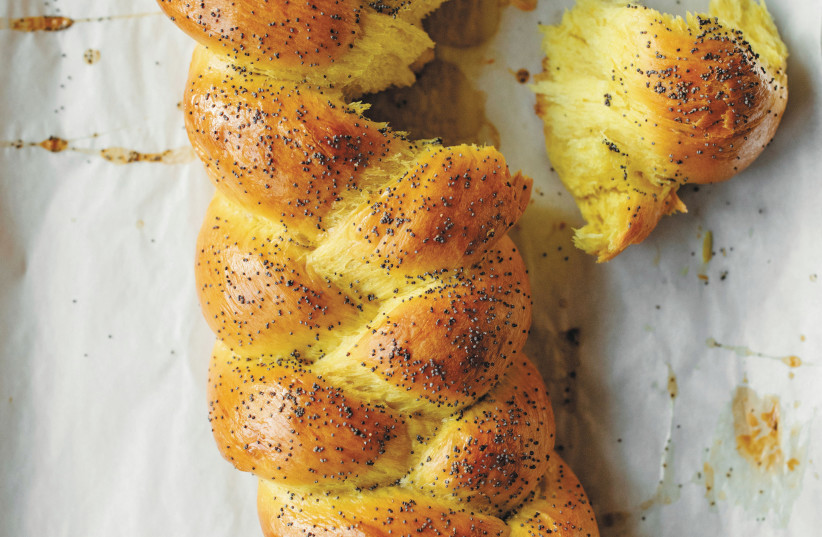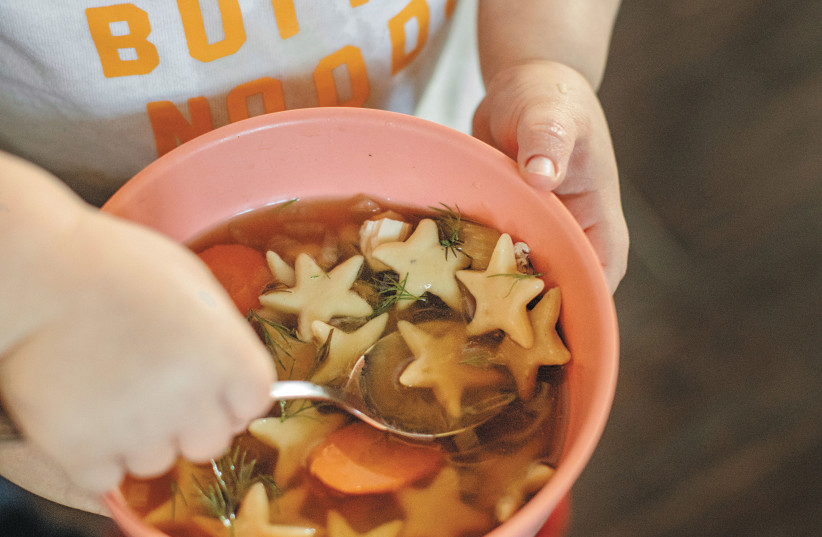If you haven’t heard of Molly Yeh yet, you’re going to be happy I’m introducing you. Yeh (pronounced “yay!”) has a life story so quirky, it sounds like she’s a protagonist in a romantic comedy.
Yeh grew up in the Chicago suburbs and was an award-winning percussionist, went to Juilliard and got a degree in percussion. She then married a fellow Juilliard alum and moved to East Grand Forks, Minnesota, to live on the sugar beet farm her husband’s family owned for five generations.
While in New York, she started a food blog, which eventually turned into her first cookbook, Molly on the Range, in 2016, and a Food Network show, Girl Meets Farm, in 2018, along with a whole bunch of TV holiday cooking specials, and now a restaurant, Bernie’s, named after her three-year-old daughter.
Yeh is the daughter of a Chinese father and a Jewish mother, and she brings both of those traditions to her recipes, along with Israeli flavors (read: a lot of tahini) she has picked up on visits to Israel, plus the Midwestern-Scandinavian cuisine of her in-laws.
Her new cookbook, Home Is Where the Eggs Are, brings together all of those influences, plus the fact that, since she wrote her first book, she has become a mother of two, putting dinner on the table every day. The result is a book filled with fun, delicious and mainly not-too-fussy meals for every day and special occasions.
Since winter has finally arrived in Israel, I’m bringing you some of Yeh’s heimish-hygge recipes to warm you on chilly, rainy nights or any winter Shabbat. [Hygge is a Scandinavian term that describes a mood of comfort, coziness and contentment.]
POTATO CHALLAH
If you have your own beloved challah recipe, like I do, it’s hard to branch out sometimes. Better to just put an interesting topping on it, you think to yourself, or braid it differently, than risk a whole new recipe.
This is not the first time Yeh has convinced me to set aside my tried-and-true for something else. Google “scallion pancake challah”; it’s an amazing Asian-Jewish fusion recipe. And in her new book, she has this potato challah, which won me over with her promise of “the same fluff in half the amount of time, like magic.”
Yeh originally tried making this with mashed potatoes but found it too time-consuming. Then, she replaced some of the flour with potato flour – the secret ingredient of her recipe for the Norwegian flatbread lefse – and struck gold.
The recipe can also be used to make sandwich bread, mini pizzas, franks in blankets (or Moses in the basket, as Israelis call them) and more.
Yield: 2 medium braided loaves
- 4 cups (520 gr.) bread flour or all-purpose flour, plus more as needed
- 1/3 cup (60 gr.) potato flour
- 2 Tbsp. (25 gr.) sugar
- 2 1/4 tsp. (1 packet) instant yeast
- 1 1/2 tsp. kosher salt
- 1 tsp. ground turmeric and a few cracks of black pepper (optional)
- 1 cup (240 gr.) warm water
- 2 large eggs
- 1/2 cup (100 gr.) neutral oil, plus a little more for the bowl
- 1 egg, beaten with a splash of water
- Flaky salt and/or seeds for toppingIn a large bowl or the bowl of a stand mixer, whisk together the flours, sugar, yeast, salt and turmeric and pepper if using. In a medium bowl or large measuring cup, whisk together the water, eggs and oil. Add the wet ingredients to the dry ingredients and use a stiff rubber spatula or wooden spoon to mostly combine into a shaggy dough. It may seem dry at first, but it will come together as you knead it. Knead, either on a work surface or with the stand mixer fitted with a dough hook on medium, adding more flour if the dough is too sticky to work with, until the dough is smooth and slightly sticky, 10-15 minutes.
- Stretch the dough into a ball, pinching the ends under to form a taut surface. Transfer to an oiled bowl (or simply oil the bowl you used to mix the dough if it isn’t too covered in dough), turning to coat the dough fully in a thin layer of oil. Cover with plastic wrap or a towel and let rise in a draft-free place until doubled in size, 1-2 hours.
- Preheat the oven to 180° and line 2 baking sheets with parchment paper and set aside.
- Braid. Cover loosely with plastic wrap or towels and let rise in a draft-free place until puffy and risen by half, 30-45 minutes.
- Brush the braided loaves with a thin layer of egg wash and sprinkle with your toppings of choice. Bake until golden brown with an internal temperature of 88°. Begin checking for doneness at 18 minutes. Switch racks about halfway through the baking time.
Leftovers: Store in an airtight container at room temperature. They are best eaten within a couple of days. After that, you can make French toast. They can also be sliced and frozen in an airtight container for a few months.
CHICKEN AND STARS SOUP
“The most gratifying requirement of being a Jewish mother is having a chicken soup practice,” Yeh writes. It’s definitely up there; I make a version of my mother’s soup, and my kids love it.
But kids also love having stars floating in their soup. Yeh’s idea comes from somewhere unfamiliar to those, like me, who keep kosher: Campbell’s soup. Unlike the canned version, Yeh’s stars are giant noodles, almost like flat dumplings. They’re more work than matza balls or regular noodles, but they’re also more fun.
This soup has the classic flavors of a Jewish chicken soup, like plenty of dill and parsley, along with some surprises, like lemon and nutmeg.
Serves 4-6.
Soup:
- One 1.6 kg. whole chicken
- 2 medium yellow onions: 1 quartered and 1 chopped
- 2 medium parsnips, trimmed: 1 cut into large chunks and 1 cut into 1/4-inch slices
- 3 large carrots, trimmed: 1 cut into large chunks and 2 cut into 1/4-inch slices
- 3 large celery stalks: 1 cut into large chunks and 2 cut into 1/4-inch slices
- 2 garlic cloves, peeled and crushed
- 2 thyme sprigs
- 6 flat-leaf parsley sprigs: 3 whole and 3 chopped
- 12 dill sprigs: 6 whole and 6 chopped, plus more for serving
- 2 bay leaves
- 1 tsp. whole black peppercorns, plus ground black pepper
- Kosher salt
- Zest and juice of half a lemon
- A few passes of freshly grated nutmeg
Egg noodle stars:
- 2 cups (260 gr.) all-purpose flour, plus more for dusting
- 1 1/2 tsp. kosher salt
- 1/4 tsp. freshly grated nutmeg
- 2 large eggs
- 1/4 cup (60 gr.) water
- Small star (or other) shaped cookie cutter
- For the soup base: In a large pot, combine the chicken, quartered onion, parsnip chunks, carrot chunks, celery chunks, garlic, thyme, the 3 whole parsley sprigs, the whole dill sprigs, the bay leaves and the peppercorns. Add cold water to cover and come up just below the top of the pot, about 5 liters. Bring to a boil and then reduce the heat to simmer at a low bubble, uncovered, until the chicken is very tender, about 1 1/2 hours (or longer if you have the time – up to 6 hours, topping off with more water if the stock dips below the chicken and veggies), skimming off any scum (there won’t be much) and, if desired, some fat.
- While the stock simmers, make the stars: In a medium bowl, whisk together the flour, salt and nutmeg, add the eggs and water and mix to form a dough. Knead for 5-7 minutes until smooth. Cover with plastic wrap or a damp towel and let rest for 20 minutes. On a floured surface, roll out the dough to 1/8 inch thickness, dusting with more flour as needed to prevent sticking, and cut out stars with a bite-sized star-shaped cookie cutter (or other small cookie cutter). Dust the stars with flour so they don’t stick together and set them aside on a sheet pan. Re-roll the scraps and repeat to use up the rest of the dough. (If you don’t have the patience for all these cutouts, you can just use a knife to cut long, thin noodles.) Set aside until ready to use.
- Carefully strain the stock, discarding all the solids except for the chicken. You should have 3-4 liters of stock. Set the chicken aside to cool briefly while you put together the rest of the soup. Return the strained stock to the pot and bring it to a simmer. Add the chopped onion, sliced parsnip, sliced carrots, sliced celery, chopped parsley, chopped dill, noodles and 1 tablespoon salt and simmer, covered, until vegetables and noodles are tender, 30-40 minutes.
- Meanwhile, pull the chicken off the bones and chop it into bite-size pieces. Season the chicken with salt and, when the vegetables and noodles are tender, add it to the soup along with the lemon zest and juice, nutmeg and ground black pepper. Taste and add more salt if needed. This is important: The amount of salt in a chicken soup can mean the difference between unappetizing chicken tea and the elixir of bubbe love that it should be. So don’t skip this step, and don’t rush it, either. Taste your soup. If it doesn’t make you smile reflexively, add more salt, about 1/2 teaspoon of it, and give it a few good stirs so it can dissolve. Taste and repeat as needed until it tastes good.
- Garnish with fresh dill and serve.
Leftovers: As a mushy noodle fan, I store the soup all together and look forward to the next day when the soup will taste even better and the noodles will be even softer. I recognize that not everyone loves a mushy noodle, though, so if you’re in this category and you expect to have leftovers, cook the noodles separately in salted boiling water to your desired doneness and store the drained leftover noodles separately as well. Leftovers will keep in the fridge for up to 3 days or in the freezer for up to 3 months. ■


